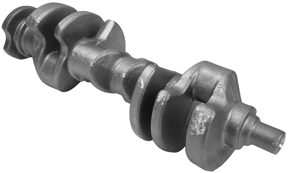 When selecting a crankshaft for a high performance application, many vehicle owners question what type of steel they should use for their crankshaft. Obviously different steels have different qualities, but the strength of their composition largely depends on the heat treating process that was used after the crankshaft was produced. Although heat treating is beyond the scope of this page, we will look at the most common grades of steel used for forged and billet crankshafts below.
When selecting a crankshaft for a high performance application, many vehicle owners question what type of steel they should use for their crankshaft. Obviously different steels have different qualities, but the strength of their composition largely depends on the heat treating process that was used after the crankshaft was produced. Although heat treating is beyond the scope of this page, we will look at the most common grades of steel used for forged and billet crankshafts below.
To better understand steel terminology, as is used by SAE and AISI, we can dissect the steel grade to determine some basic information. For example, the number 4340 can be broken down into two sets of digits. The number 43 represents the primary composition of the crankshaft beyond iron, which in this case includes nickel, chromium and molybdenum. The second set of digits represents the amount of carbon present in the steel in hundredths. Therefore, the number 40 represents a .40% carbon content.
4340 Crankshafts
4340 steel crankshafts contain 1.82% nickel, .50-.80% chromium, .25% molybdenum and .40% carbon. The remaining composition is primarily made up of iron (95-96%). This is one of the most common steels used for both aftermarket crankshafts and connecting rods. 4340 steel has a tensile strength that equals or exceeds 108,000 PSI. Because of the composition of this material, it responds well to heat treating and the final piece is quite durable.
4330 Crankshafts
Similar to the 4340 classification, 4330 steel crankshafts primarily consist of 95-98% iron, 1.82% nickel, .50-.80% chromium and .25% molybdenum. However, 4340 steel does have a lower carbon content of .30%. 4330 crankshafts have a high tensile strength that exceeds 125,000 PSI. Although a high tensile strength is desired in high performance applications, 4330 steel is less resilient to fatigue and is more prone to break if the crankshaft flexes.
4130 Crankshafts
4130 steel crankshafts contain .50-.95% chromium, .12-.30% molybdenum, .40-.60% manganese, .28-.33% carbon and an iron content that ranges from 97-98%. With a 66,700 PSI tensile strength, this is one of the weakest alloy steels used in aftermarket crankshafts. However, 4130 is ideal for light performance applications and often appeals to consumers because the cost is considerably less than higher grade steels.
5140 Crankshafts
Although less popular, 5140 steel crankshafts are used in mild performance applications and are classified in the chromium steel category. These crankshafts are comprised of 97-98% iron, .70-.90% manganese, .70-.90% chromium and .38-.43% carbon. 5140 steel crankshafts also contain lesser amounts of silicon, sulfur and phosphorous. 5140 steel has a tensile strength of 82,700 PSI, making it less brittle when compared to 4330 or 4340 steel crankshafts.
So which type of steel is best for your crankshaft? This determination is based on ones horsepower requirements and budget. Generally speaking, we prefer 4340 steel over all other options, particularly if the existing crankshaft can’t be repaired. There are many 4340 steel crankshafts powering engines that exceed 1,000 HP, which have proven to be quite durable for racing applications. Although many automotive enthusiasts like to compare 4330 –vs- 4340 steel, for example, their material compositions are not that dissimilar. How the crankshaft is hardened is more detrimental in obtaining the benefits from the composition of each crankshaft.
Now that you have learned more about the most popular grades of steel that are used to manufacture crankshafts, please rate this page below.
